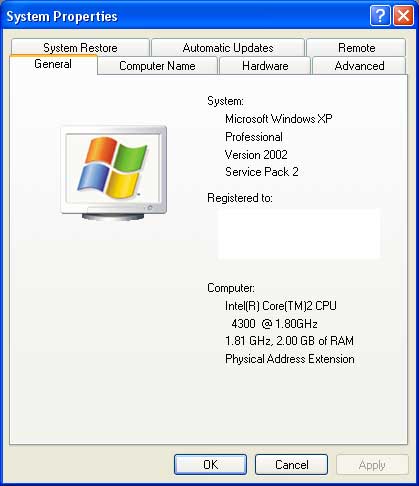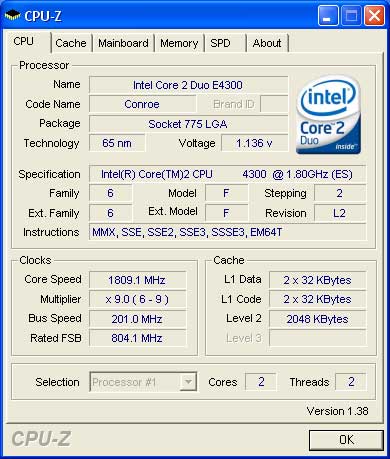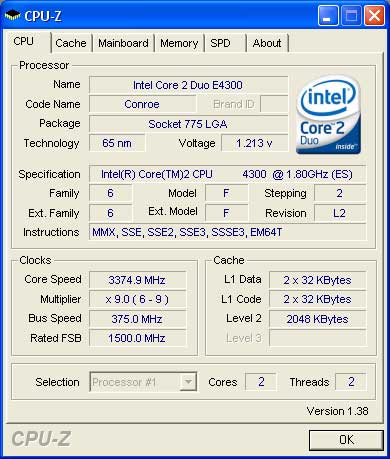Intel Core 2 Duo E4300: Affordable and Highly Overclockable
by Anand Lal Shimpi on January 10, 2007 2:45 AM EST- Posted in
- CPUs
Introducing the 4000 series
With the E6420 and E6320 getting 4MB L2s, there's now room for a lower end Core 2 Duo SKU with a 2MB L2 cache again: enter the Core 2 Duo E4000 series. Due to launch this month, the Core 2 Duo E4300 will eventually be followed by the Core 2 Duo E4400 (released in Q2). Both are dual core offerings like their 6000 series siblings, but differentiate themselves by only featuring a 2MB L2 cache, lower clock speeds, 800MHz FSB and feature no support for Intel Virtualization Technology. However, given that VT isn't anywhere near being a mainstream requirement, the E4000 series ends up being a cheap way of getting Core 2 Duo performance.

The E4000 series is based on Intel's Allendale core, not Conroe, so there's physically only 2MB of cache on the die itself (not 4MB with half of the cache disabled). The end result is that these chips are cheaper to make, cooler running and should be pretty overclockable.

The E4300 will launch first at 1.80GHz (200MHz x 9.0), followed by the E4400 at 2.0GHz (200MHz x 10.0). Since the clock multiplier is fixed at 9.0, the only hope for overclocking is by increasing the FSB frequency. With such a low default clock multiplier, you can actually overclock the chip pretty easily.

Using Gigabyte's GA-965P-DS3 motherboard, our engineering sample was able to run at 3.375GHz (375MHz x 9.0) at 1.468V using a stock Intel cooler. Although the E4300 still only has a 2MB L2 cache, when overclocked to over 3.3GHz you end up with a chip that's faster than Intel's Core 2 Extreme X6800 - at only $163. The E4300 gets even better in Q2 when its price will drop from $163 to $133, making it even more of a bargain.
The Test
Today's review will focus on the overall performance of the E4300 at stock speeds as well as when overclocked. At stock speeds the E4300 is priced as a cheaper alternative to the Core 2 Duo E6300 and AMD's Athlon 64 X2 3800+, thus the comparison between those two chips is obvious. When overclocked however, the E4300 can hang with the best of the best and thus you'll see comparisons all the way up to the X6800 and Athlon 64 X2 5000+.
We wanted to showcase the performance potential of the E4300 without resorting to more expensive 1066MHz or faster memory and thus we used a 2:1 memory-to-FSB ratio at stock speeds (DDR2-800) and 1:1 ratio for overclocking, resulting in our memory running at DDR2-750. With more expensive memory the overclocked E4300 would perform even better but our focus was on best bang for your buck with the chip and how well it can overclock. As you will soon see, you don't need anything faster than DDR2-800 memory to make the E4300 a very compelling chip.
| CPU: | Intel Core 2 Duo X6800 (2.93GHz/4MB) Intel Core 2 Duo E6600 (2.40GHz/4MB) Intel Core 2 Duo E6400 (2.13GHz/2MB) Intel Core 2 Duo E6300 (1.86GHz/2MB) Intel Core 2 Duo E4300 (1.80GHz/2MB) AMD Athlon 64 X2 5000+ AMD Athlon 64 X2 4600+ AMD Athlon 64 X2 4200+ AMD Athlon 64 X2 3800+ |
| Motherboard: | Gigabyte GA-965P-DS3 ASUS M2N32-SLI Deluxe |
| Chipset: | Intel P965 nForce 590 SLI |
| Chipset Drivers: | Intel 8.1.1.1010 NVIDIA 9.35 |
| Hard Disk: | Seagate 7200.9 300GB SATA |
| Memory: | Corsair XMS2 DDR2-800 4-4-4-12 (1GB x 2) |
| Video Card: | NVIDIA GeForce 8800 GTX |
| Video Drivers: | NVIDIA ForceWare 97.44 |
| Resolution: | 1600 x 1200 |
| OS: | Windows XP Professional SP2 |










68 Comments
View All Comments
sdsdv10 - Wednesday, January 10, 2007 - link
I think the point was, with higher multiplier of the 4300 over the 6300 (or 6320) you don't need to go to such high FSB numbers (requiring more expensive DDR2 RAM) to get a good overclock. That might save you another $25-50. So for a MB, CPU and RAM combo you would pay say $450 for a 6300 setup, but you "may" get the same performance out of a 4300 setup for ~$350 (say $50 less on the CPU and another $50 on the RAM, roughly 20-25% less). That's a nice savings for those on a tight buget.atenza - Wednesday, January 10, 2007 - link
Exactly! And it's also good news for people like me, who want to build a nice little (yet overclocked) Micro-ATX system. None of those boards currently gets anywhere beyond ~330 FSB. At 333MHz FSB, the E6300 would only run at 2.33 GHz. The E4300 would achieve 3.00 GHz, which is enough for me.Patrese - Wednesday, January 10, 2007 - link
If it doesn't come to Brazil with the ridiculous price premiums the rest of the Core 2 line is coming (an E6600 costs US$550 here!), that chip is destined to be the next one I have, so that I can get rid of my good-old Athlon XP 3200+... Great news in that sense, but what I find really irritating about Intel is the short life of their chipsets and motherboards... Every year or so I'd have to upgrade my motherboard to upgrade processors.BTW, no AMD fanboy here... If K8L proves to be troublesome on AM2 motherboards you're gonna see me complaining about that too. I just find the idea of upgrading motherboards so fast irritating... :(
1111111 - Wednesday, January 10, 2007 - link
The Windows Media Encoder chart shows the E4300 faster than the X2 3800+ and the D945...so either the chart is wrong or the sentence is wrong:)
JarredWalton - Wednesday, January 10, 2007 - link
See above - fixed.harpoon84 - Wednesday, January 10, 2007 - link
"Windows Media Encoder is far more favorable to AMD CPUs and thus the E4300 ends up being a little slower than the X2 3800+. Our overclocked chip ends up, once again, on top of the charts."Actually, the E4300 is faster than the X2 3800+ in this test.
"At stock speeds, the E4300 ends up offering similar performance to the Athlon 64 X2 3800+."
You are being overly kind to the X2 3800+. The E4300 beats it in the majority of the benchmarks. The E4300 is the equal of the X2 4200+ if you tally up the results.
JarredWalton - Wednesday, January 10, 2007 - link
I have edited these two paragraphs to better reflect the results. The X2 3800+ is currently $30 cheaper than the initial launch price of the E4300, so it's still the cheapest way to get into a dual core setup without getting the power requirements of NetBurst, but I don't think most of us would really recommend X2 3800+ over the E4300... it's about a tie in terms of recommendation, depending on the intended use.duploxxx - Wednesday, January 10, 2007 - link
well if you wouldn't recommend the 3800 over the e4300 maybe oc' wise yess, but don't forget to mention that a decent intel chipset also costs 30$ more than the amd solution...so pricewise a and performance wise 4200 is still more interesting than the e4300 unless you oc.
try some vista benchmarks and you'll see what the best chips are future wise...... AMD for sure.
OcHungry - Wednesday, January 10, 2007 - link
I think people have misconception about AMD and vista (64bit). Have you run the 64bit vista? most of the benchmarks I tried w/ AMD's dual core were slower or froze cold. Vista has a long ways to go yet to be a choice OS. There is also the 32bit version of vista if you want C2D to run it. As for me I will not run vista until its matured and games can run faster (than winxp). Nvidia has not created a bug free vista driver yet. The latest nvidia vista (64bit) driver I installed turned out buggy and did not fully install (No nvidia display panel). I dont know, maybe it was me. But I have practically given up on it and am back to winxp.JarredWalton - Wednesday, January 10, 2007 - link
There seems to be an assumption by some people that Core 2 is going to somehow be slower in 64-bit mode. I highly doubt this for a couple reason: one, AMD isn't faster in 32-bit; two, 64-bit vs. 32-bit isn't a huge difference in architecture. Basically, 64-bit is just 64-bit registers and a few extra opcodes.